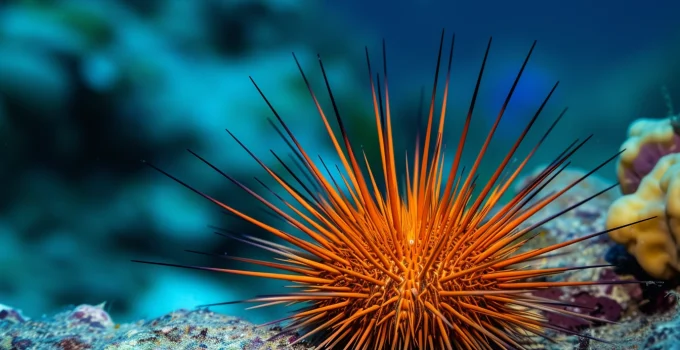In the vast expanse of the ocean lies a hidden gem, a creature both mysterious and enchanting—the sea urchin. These fascinating marine animals, often overlooked by casual beachcombers, hold within them a world of wonders waiting to be discovered. In this article, we’ll delve into the captivating realm of sea urchins, exploring their unique characteristics, ecological significance, and culinary delights. Join us as we embark on a journey to unlock the ocean treasures hidden within the urchin.
Contents
Sea Urchin: Guardians of the Ocean Floor

A Closer Look: Anatomy and Adaptations of Sea Urchins
Sea urchins belong to the phylum Echinodermata, a group of marine animals characterized by their radial symmetry and spiny skin. These fascinating creatures come in a variety of shapes, sizes, and colors, ranging from small, round specimens to large, elongated ones. Their spherical bodies are covered in sharp, needle-like spines that serve as a protective armor against predators and rough ocean currents.
Life on the Ocean Floor: Habitat and Behavior of Sea Urchins
Sea urchins inhabit a wide range of marine environments, from shallow coastal waters to deep-sea trenches. They are often found grazing on rocky reefs, coral reefs, and sandy seabeds, where they play a crucial role in maintaining the health and balance of marine ecosystems. Urchins are herbivores, feeding primarily on algae, kelp, and other marine vegetation. Using their specialized watitoto feeding appendages called “Aristotle’s lantern,” they scrape algae off rocks and ingest them through their mouth located on the underside of their body.
Ecological Significance: Guardians of Marine Biodiversity
Keystone Species: The Role of Sea Urchins in Marine Ecosystems
Sea urchins are considered keystone species in many marine ecosystems, meaning they have a disproportionately large impact on the structure and function of their environment relative to their abundance. By grazing on algae, urchins help prevent overgrowth of seaweed and maintain the health of coral reefs and rocky habitats. Their feeding habits create patches of bare rock, which provide essential habitat for a diverse array of marine life, including fish, crustaceans, and other invertebrates.
Balancing Act: The Importance of Sea Urchin Populations
The abundance and distribution of sea urchin populations are closely linked to the health and resilience of marine ecosystems. In some regions, overfishing and habitat destruction have led to declines in urchin populations, resulting in ecosystem imbalances and shifts in species composition. Conversely, in areas where urchins are abundant, their grazing activities can have significant ecological impacts, shaping the structure and dynamics of marine communities.
Culinary Delights: Exploring the Gastronomic Pleasures of Sea Urchins
A Delicacy from the Sea: The Culinary Appeal of Sea Urchins
Beyond their ecological significance, sea urchins are prized for their culinary appeal, particularly in coastal regions around the world. Known for their rich, creamy texture and delicate flavor, urchins are often enjoyed raw or lightly cooked, allowing their natural sweetness to shine. In many cultures, urchins are considered a delicacy, enjoyed in dishes ranging from sushi and sashimi to pasta and risotto.
Harvesting and Preparation: From Ocean to Table
Harvesting sea urchins is a delicate process that requires skill and expertise to ensure sustainability and minimize impact on natural populations. In some regions, commercial fisheries carefully harvest urchins using specialized tools and techniques, while in others, they are harvested by hand by local fishermen and divers. Once harvested, urchins are carefully cleaned and prepared for consumption, with their roe, or “uni,” prized as the most sought-after part of the animal.
Embracing the Wonder of Sea Urchins

In conclusion, sea urchins are remarkable creatures that play a vital role in the health and balance of marine ecosystems. From their unique anatomy and adaptations to their ecological significance and culinary delights, urchins embody the wonders of the ocean and the interconnectedness of marine life. By unlocking the treasures hidden within the urchin, we gain a deeper appreciation for the beauty and complexity of the natural world and the importance of protecting and preserving our ocean environments for future generations to enjoy. So let us continue to explore, learn, and marvel at the enchanting world of urchins, guardians of the ocean floor and treasures of the deep.




